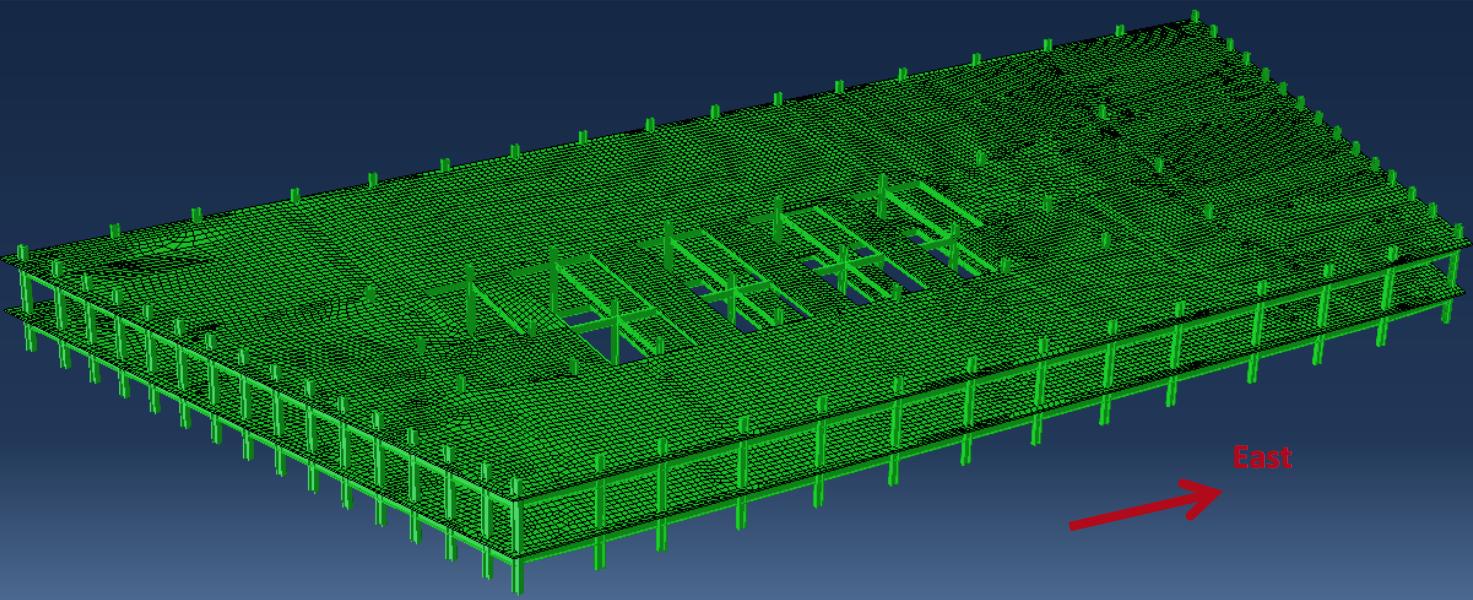
3 minute read
2.6.2 ABAQUS Analysis
Figure 2.59 Displacement (inches) of the floor system surrounding Column 79.
2.6.2 ABAQUS Analysis
Advertisement
Figure 2.60 is a three-dimensional depiction of our ABAQUS model for Floors 12 and 13. The Floor 12 x-direction movement is shown in Figure 2.61. The Floor 13 x-direction movement is shown in Figure 2.62. The x-direction movement around Column 79 is shown in Figure 2.63. The x-direction movement of the floor system surrounding Column 79 was found to be 1.85 inches, and the y-direction movement was found to be 0.94 inches. Prior to modeling a given floor or two floor system, the UAF research team examined column stiffness between floors; this resulted in springs to accommodate floor framing above and below a given number of floors. The UAF team subsequently introduced axial and transverse column stiffness between floors 12 and 13, see Figure 2.60. This was also verified by including both floors 12 and 13 in a separate model (not shown) and in that model, the column stiffness below floor 12 and above floor 13 were included. The results were compared as a quality control check on our modeling methodology.

Figure 2.60 ABAQUS Model for Floors 12 and 13.

Figure 2.61 Movement (inches) in x-direction at Floor 12.

Figure 2.62 Movement (inches) in x-direction at Floor 13.

Figure 2.63 Movement (inches) in x-direction at Floor 13 around Column 79.
According to NIST, the initiating failure occurred at the connection between Column 79 and girder A2001 at Floor 13 due to a relative displacement of girder A2001 of 6.25 inches. Our ABAQUS analysis corroborated the findings of our SAP2000 analysis, showing that girder A2001 would undergo less than one inch of westward displacement relative to Column 79 under the worst-case fire condition. Examining all possible conditions, our analysis found that the westward movement of girder A2001 relative to the base plate on Column 79 was 3.68” for noncomposite, 2.18” for partially composite and less than 1” for composite behavior (the condition at time of the fire).
2.6.2.1 ABAQUS Analysis with NIST Boundary Conditions and No Spatial Restrictions Subsequently, we studied the relative movement between Column 79 and girder A2001 in the worst-case condition to identify the maximum relative displacement at this connection in a higher temperature environment and without restriction from other frames, columns, and the deck. The part of the Floor 13 frame we examined is shown in red in Figure 2.64.

Figure 2.64 The part of the Floor 13 frame we examined is shown in red.
The boundary conditions reported by NIST and the assigned temperature distribution are shown in Figure 2.65 below. The concrete deck was not included in this model to ensure free expansion of the steel frame. The assigned temperature is also higher than the expected fire condition.
Figure 2.66 shows our calculation of the transverse displacement of the steel frame assuming the boundary conditions used by NIST. The horizontal displacement at the end of girder A2001 and Column 79 was calculated by our team to be 5.11 inches in the west direction. As stated above, it is important to note these boundary conditions, which were chosen by NIST, do not reflect the actual boundary conditions for Floors 12 and 13. The exterior frame is actually flexible and not fixed. The thermal point of zero movement is actually near the elevators where the building framing is stiffer. Furthermore, as stated above, all restrictions caused by other frames, columns, and the deck were excluded from this analysis. When we incorporate NIST’s boundary conditions and remove all restrictions to lateral movement, such as the Column 79 side plates, we find that the westward displacement of girder A2001 relative to Column 79 is 5.11 inches, which is a full inch less than the 6.25 inches of westward relative displacement reported by NIST, and nearly an inch less than the 6 inches westward displacement required to push the web of girder A2001 past its 12-inch seat at Column 79.

Figure 2.65 Local frame boundary conditions reported by NIST.









